The Global Economy: Free Trade, Liberalization, Climate Change Impact
VerifiedAdded on 2022/08/25
|13
|3496
|42
Essay
AI Summary
This essay delves into the complexities of the global economy, examining the concepts of free trade and trade liberalization, and their multifaceted impacts. It explores the arguments both for and against free trade, highlighting the roles of organizations like the WTO, and the potential economic benefits such as lower consumer costs, increased efficiency, and global output, as well as disadvantages, including the potential for developed countries to benefit at the expense of less developed ones, and the impacts of climate change. The essay also discusses the challenges of global economic governance related to climate change, considering its effects on economic development and environmental degradation, and the role of government intervention, international bodies, and various financial and legal perspectives. The analysis includes discussions on climate change, its consequences like rising temperatures, volatile weather patterns, and the need for international collaboration and investment to mitigate the effects of climate change.
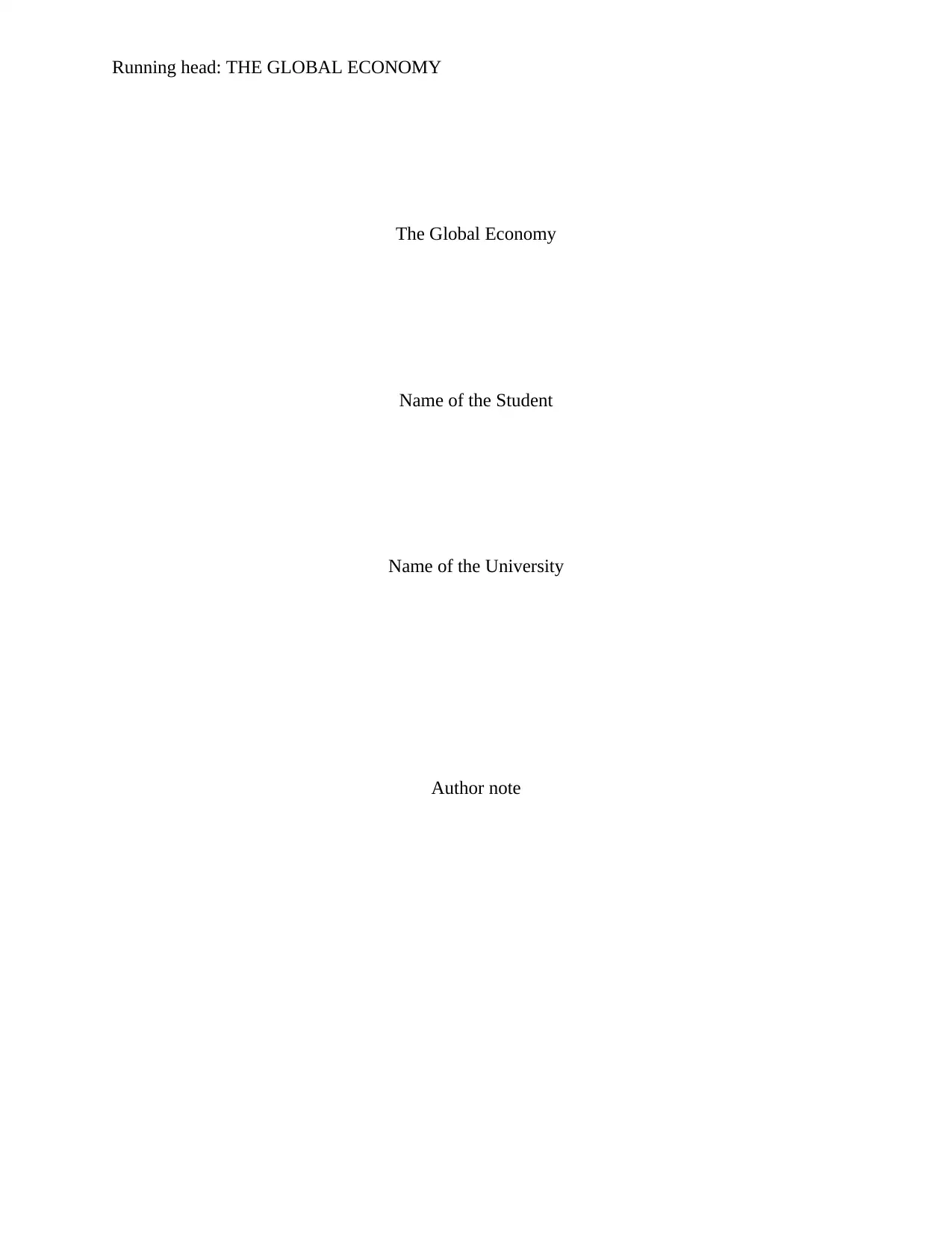
Running head: THE GLOBAL ECONOMY
The Global Economy
Name of the Student
Name of the University
Author note
The Global Economy
Name of the Student
Name of the University
Author note
Paraphrase This Document
Need a fresh take? Get an instant paraphrase of this document with our AI Paraphraser
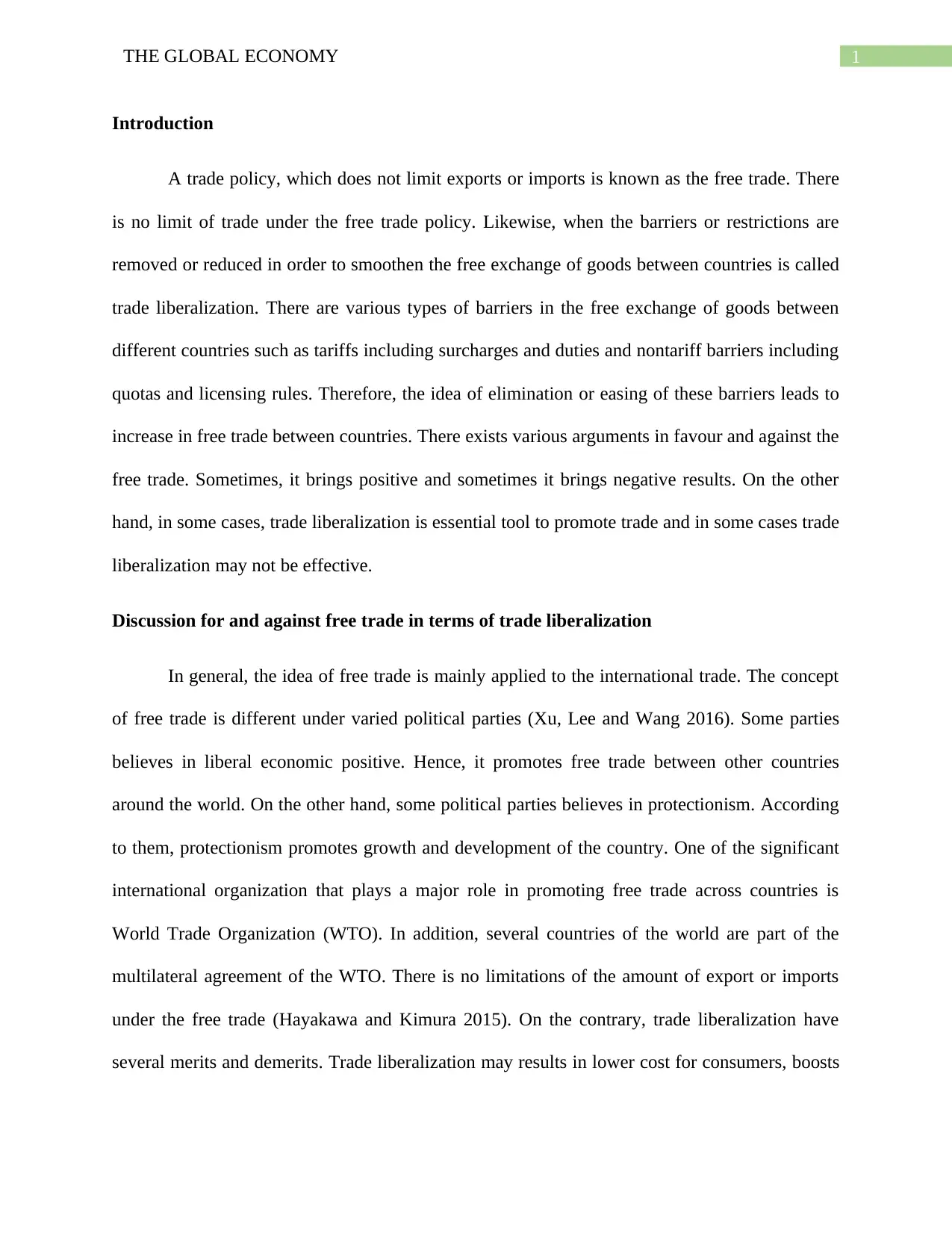
1THE GLOBAL ECONOMY
Introduction
A trade policy, which does not limit exports or imports is known as the free trade. There
is no limit of trade under the free trade policy. Likewise, when the barriers or restrictions are
removed or reduced in order to smoothen the free exchange of goods between countries is called
trade liberalization. There are various types of barriers in the free exchange of goods between
different countries such as tariffs including surcharges and duties and nontariff barriers including
quotas and licensing rules. Therefore, the idea of elimination or easing of these barriers leads to
increase in free trade between countries. There exists various arguments in favour and against the
free trade. Sometimes, it brings positive and sometimes it brings negative results. On the other
hand, in some cases, trade liberalization is essential tool to promote trade and in some cases trade
liberalization may not be effective.
Discussion for and against free trade in terms of trade liberalization
In general, the idea of free trade is mainly applied to the international trade. The concept
of free trade is different under varied political parties (Xu, Lee and Wang 2016). Some parties
believes in liberal economic positive. Hence, it promotes free trade between other countries
around the world. On the other hand, some political parties believes in protectionism. According
to them, protectionism promotes growth and development of the country. One of the significant
international organization that plays a major role in promoting free trade across countries is
World Trade Organization (WTO). In addition, several countries of the world are part of the
multilateral agreement of the WTO. There is no limitations of the amount of export or imports
under the free trade (Hayakawa and Kimura 2015). On the contrary, trade liberalization have
several merits and demerits. Trade liberalization may results in lower cost for consumers, boosts
Introduction
A trade policy, which does not limit exports or imports is known as the free trade. There
is no limit of trade under the free trade policy. Likewise, when the barriers or restrictions are
removed or reduced in order to smoothen the free exchange of goods between countries is called
trade liberalization. There are various types of barriers in the free exchange of goods between
different countries such as tariffs including surcharges and duties and nontariff barriers including
quotas and licensing rules. Therefore, the idea of elimination or easing of these barriers leads to
increase in free trade between countries. There exists various arguments in favour and against the
free trade. Sometimes, it brings positive and sometimes it brings negative results. On the other
hand, in some cases, trade liberalization is essential tool to promote trade and in some cases trade
liberalization may not be effective.
Discussion for and against free trade in terms of trade liberalization
In general, the idea of free trade is mainly applied to the international trade. The concept
of free trade is different under varied political parties (Xu, Lee and Wang 2016). Some parties
believes in liberal economic positive. Hence, it promotes free trade between other countries
around the world. On the other hand, some political parties believes in protectionism. According
to them, protectionism promotes growth and development of the country. One of the significant
international organization that plays a major role in promoting free trade across countries is
World Trade Organization (WTO). In addition, several countries of the world are part of the
multilateral agreement of the WTO. There is no limitations of the amount of export or imports
under the free trade (Hayakawa and Kimura 2015). On the contrary, trade liberalization have
several merits and demerits. Trade liberalization may results in lower cost for consumers, boosts
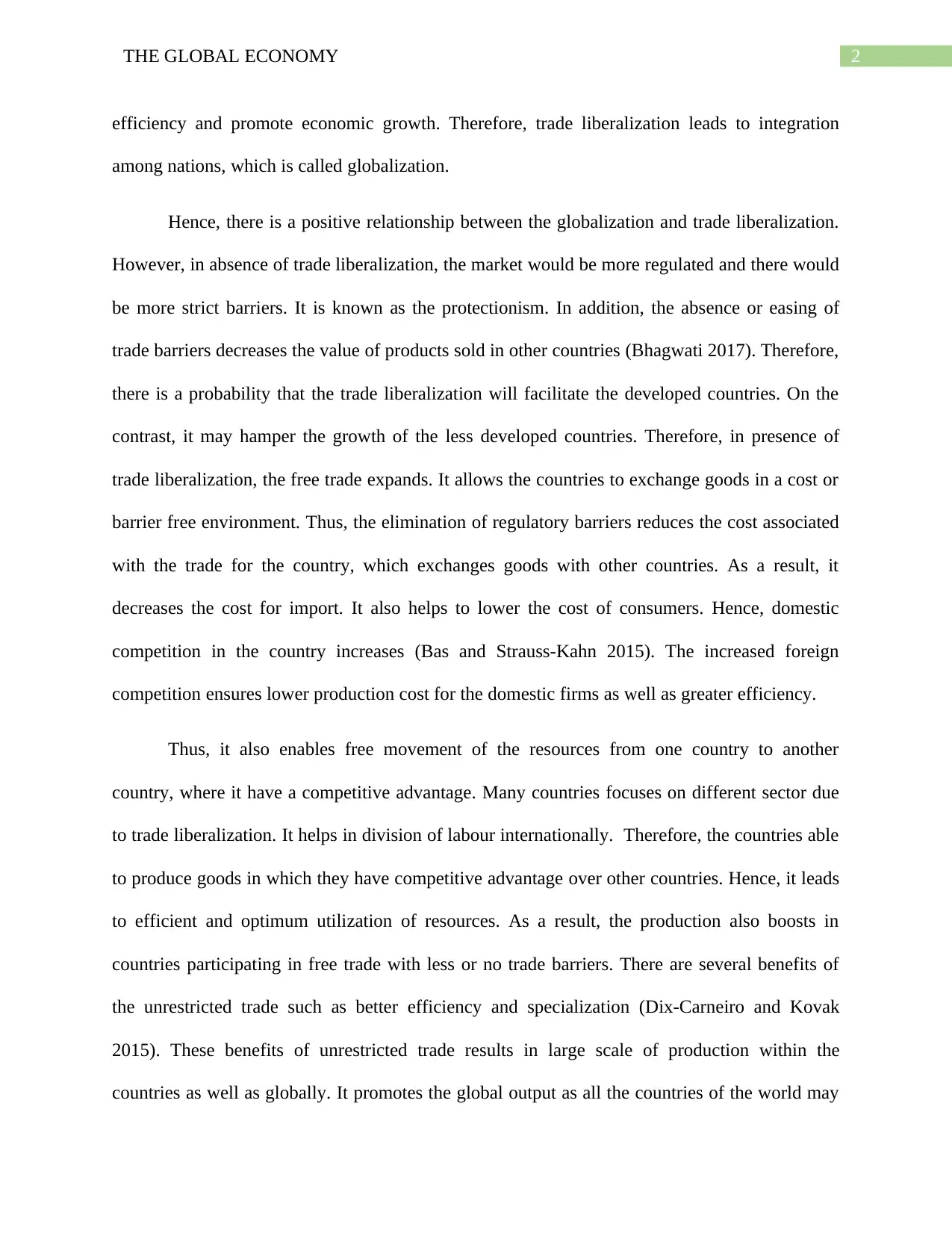
2THE GLOBAL ECONOMY
efficiency and promote economic growth. Therefore, trade liberalization leads to integration
among nations, which is called globalization.
Hence, there is a positive relationship between the globalization and trade liberalization.
However, in absence of trade liberalization, the market would be more regulated and there would
be more strict barriers. It is known as the protectionism. In addition, the absence or easing of
trade barriers decreases the value of products sold in other countries (Bhagwati 2017). Therefore,
there is a probability that the trade liberalization will facilitate the developed countries. On the
contrast, it may hamper the growth of the less developed countries. Therefore, in presence of
trade liberalization, the free trade expands. It allows the countries to exchange goods in a cost or
barrier free environment. Thus, the elimination of regulatory barriers reduces the cost associated
with the trade for the country, which exchanges goods with other countries. As a result, it
decreases the cost for import. It also helps to lower the cost of consumers. Hence, domestic
competition in the country increases (Bas and Strauss-Kahn 2015). The increased foreign
competition ensures lower production cost for the domestic firms as well as greater efficiency.
Thus, it also enables free movement of the resources from one country to another
country, where it have a competitive advantage. Many countries focuses on different sector due
to trade liberalization. It helps in division of labour internationally. Therefore, the countries able
to produce goods in which they have competitive advantage over other countries. Hence, it leads
to efficient and optimum utilization of resources. As a result, the production also boosts in
countries participating in free trade with less or no trade barriers. There are several benefits of
the unrestricted trade such as better efficiency and specialization (Dix-Carneiro and Kovak
2015). These benefits of unrestricted trade results in large scale of production within the
countries as well as globally. It promotes the global output as all the countries of the world may
efficiency and promote economic growth. Therefore, trade liberalization leads to integration
among nations, which is called globalization.
Hence, there is a positive relationship between the globalization and trade liberalization.
However, in absence of trade liberalization, the market would be more regulated and there would
be more strict barriers. It is known as the protectionism. In addition, the absence or easing of
trade barriers decreases the value of products sold in other countries (Bhagwati 2017). Therefore,
there is a probability that the trade liberalization will facilitate the developed countries. On the
contrast, it may hamper the growth of the less developed countries. Therefore, in presence of
trade liberalization, the free trade expands. It allows the countries to exchange goods in a cost or
barrier free environment. Thus, the elimination of regulatory barriers reduces the cost associated
with the trade for the country, which exchanges goods with other countries. As a result, it
decreases the cost for import. It also helps to lower the cost of consumers. Hence, domestic
competition in the country increases (Bas and Strauss-Kahn 2015). The increased foreign
competition ensures lower production cost for the domestic firms as well as greater efficiency.
Thus, it also enables free movement of the resources from one country to another
country, where it have a competitive advantage. Many countries focuses on different sector due
to trade liberalization. It helps in division of labour internationally. Therefore, the countries able
to produce goods in which they have competitive advantage over other countries. Hence, it leads
to efficient and optimum utilization of resources. As a result, the production also boosts in
countries participating in free trade with less or no trade barriers. There are several benefits of
the unrestricted trade such as better efficiency and specialization (Dix-Carneiro and Kovak
2015). These benefits of unrestricted trade results in large scale of production within the
countries as well as globally. It promotes the global output as all the countries of the world may
⊘ This is a preview!⊘
Do you want full access?
Subscribe today to unlock all pages.

Trusted by 1+ million students worldwide
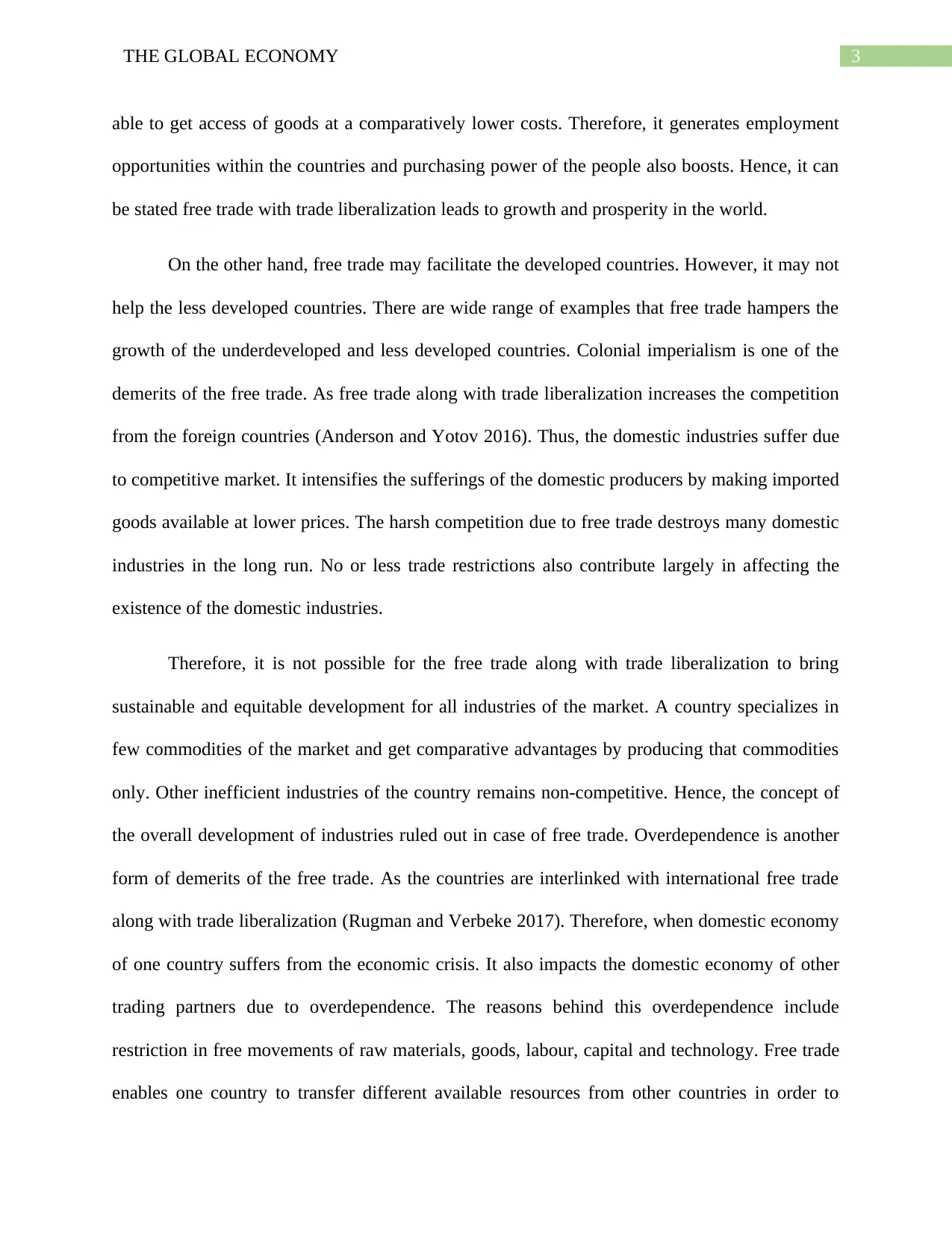
3THE GLOBAL ECONOMY
able to get access of goods at a comparatively lower costs. Therefore, it generates employment
opportunities within the countries and purchasing power of the people also boosts. Hence, it can
be stated free trade with trade liberalization leads to growth and prosperity in the world.
On the other hand, free trade may facilitate the developed countries. However, it may not
help the less developed countries. There are wide range of examples that free trade hampers the
growth of the underdeveloped and less developed countries. Colonial imperialism is one of the
demerits of the free trade. As free trade along with trade liberalization increases the competition
from the foreign countries (Anderson and Yotov 2016). Thus, the domestic industries suffer due
to competitive market. It intensifies the sufferings of the domestic producers by making imported
goods available at lower prices. The harsh competition due to free trade destroys many domestic
industries in the long run. No or less trade restrictions also contribute largely in affecting the
existence of the domestic industries.
Therefore, it is not possible for the free trade along with trade liberalization to bring
sustainable and equitable development for all industries of the market. A country specializes in
few commodities of the market and get comparative advantages by producing that commodities
only. Other inefficient industries of the country remains non-competitive. Hence, the concept of
the overall development of industries ruled out in case of free trade. Overdependence is another
form of demerits of the free trade. As the countries are interlinked with international free trade
along with trade liberalization (Rugman and Verbeke 2017). Therefore, when domestic economy
of one country suffers from the economic crisis. It also impacts the domestic economy of other
trading partners due to overdependence. The reasons behind this overdependence include
restriction in free movements of raw materials, goods, labour, capital and technology. Free trade
enables one country to transfer different available resources from other countries in order to
able to get access of goods at a comparatively lower costs. Therefore, it generates employment
opportunities within the countries and purchasing power of the people also boosts. Hence, it can
be stated free trade with trade liberalization leads to growth and prosperity in the world.
On the other hand, free trade may facilitate the developed countries. However, it may not
help the less developed countries. There are wide range of examples that free trade hampers the
growth of the underdeveloped and less developed countries. Colonial imperialism is one of the
demerits of the free trade. As free trade along with trade liberalization increases the competition
from the foreign countries (Anderson and Yotov 2016). Thus, the domestic industries suffer due
to competitive market. It intensifies the sufferings of the domestic producers by making imported
goods available at lower prices. The harsh competition due to free trade destroys many domestic
industries in the long run. No or less trade restrictions also contribute largely in affecting the
existence of the domestic industries.
Therefore, it is not possible for the free trade along with trade liberalization to bring
sustainable and equitable development for all industries of the market. A country specializes in
few commodities of the market and get comparative advantages by producing that commodities
only. Other inefficient industries of the country remains non-competitive. Hence, the concept of
the overall development of industries ruled out in case of free trade. Overdependence is another
form of demerits of the free trade. As the countries are interlinked with international free trade
along with trade liberalization (Rugman and Verbeke 2017). Therefore, when domestic economy
of one country suffers from the economic crisis. It also impacts the domestic economy of other
trading partners due to overdependence. The reasons behind this overdependence include
restriction in free movements of raw materials, goods, labour, capital and technology. Free trade
enables one country to transfer different available resources from other countries in order to
Paraphrase This Document
Need a fresh take? Get an instant paraphrase of this document with our AI Paraphraser
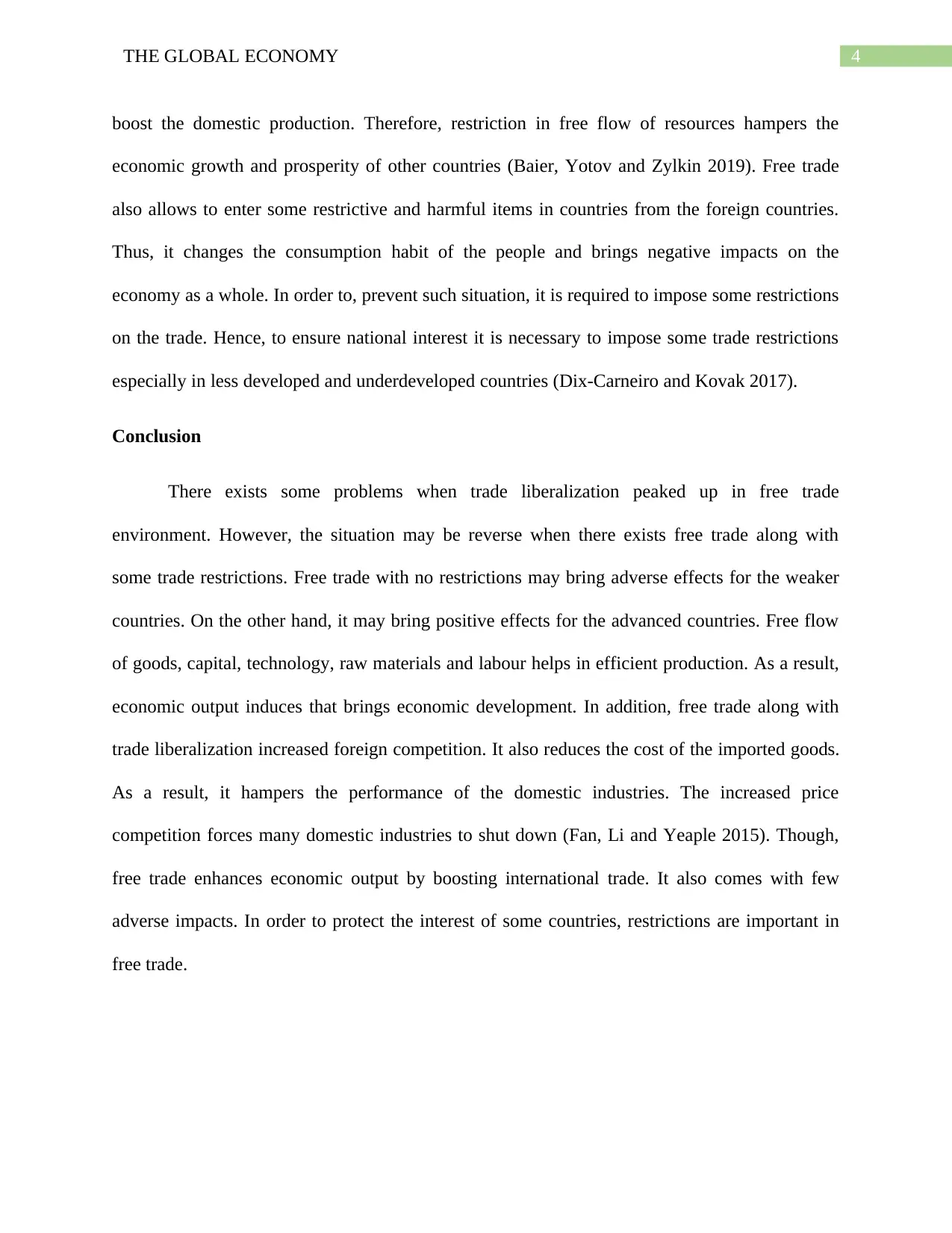
4THE GLOBAL ECONOMY
boost the domestic production. Therefore, restriction in free flow of resources hampers the
economic growth and prosperity of other countries (Baier, Yotov and Zylkin 2019). Free trade
also allows to enter some restrictive and harmful items in countries from the foreign countries.
Thus, it changes the consumption habit of the people and brings negative impacts on the
economy as a whole. In order to, prevent such situation, it is required to impose some restrictions
on the trade. Hence, to ensure national interest it is necessary to impose some trade restrictions
especially in less developed and underdeveloped countries (Dix-Carneiro and Kovak 2017).
Conclusion
There exists some problems when trade liberalization peaked up in free trade
environment. However, the situation may be reverse when there exists free trade along with
some trade restrictions. Free trade with no restrictions may bring adverse effects for the weaker
countries. On the other hand, it may bring positive effects for the advanced countries. Free flow
of goods, capital, technology, raw materials and labour helps in efficient production. As a result,
economic output induces that brings economic development. In addition, free trade along with
trade liberalization increased foreign competition. It also reduces the cost of the imported goods.
As a result, it hampers the performance of the domestic industries. The increased price
competition forces many domestic industries to shut down (Fan, Li and Yeaple 2015). Though,
free trade enhances economic output by boosting international trade. It also comes with few
adverse impacts. In order to protect the interest of some countries, restrictions are important in
free trade.
boost the domestic production. Therefore, restriction in free flow of resources hampers the
economic growth and prosperity of other countries (Baier, Yotov and Zylkin 2019). Free trade
also allows to enter some restrictive and harmful items in countries from the foreign countries.
Thus, it changes the consumption habit of the people and brings negative impacts on the
economy as a whole. In order to, prevent such situation, it is required to impose some restrictions
on the trade. Hence, to ensure national interest it is necessary to impose some trade restrictions
especially in less developed and underdeveloped countries (Dix-Carneiro and Kovak 2017).
Conclusion
There exists some problems when trade liberalization peaked up in free trade
environment. However, the situation may be reverse when there exists free trade along with
some trade restrictions. Free trade with no restrictions may bring adverse effects for the weaker
countries. On the other hand, it may bring positive effects for the advanced countries. Free flow
of goods, capital, technology, raw materials and labour helps in efficient production. As a result,
economic output induces that brings economic development. In addition, free trade along with
trade liberalization increased foreign competition. It also reduces the cost of the imported goods.
As a result, it hampers the performance of the domestic industries. The increased price
competition forces many domestic industries to shut down (Fan, Li and Yeaple 2015). Though,
free trade enhances economic output by boosting international trade. It also comes with few
adverse impacts. In order to protect the interest of some countries, restrictions are important in
free trade.
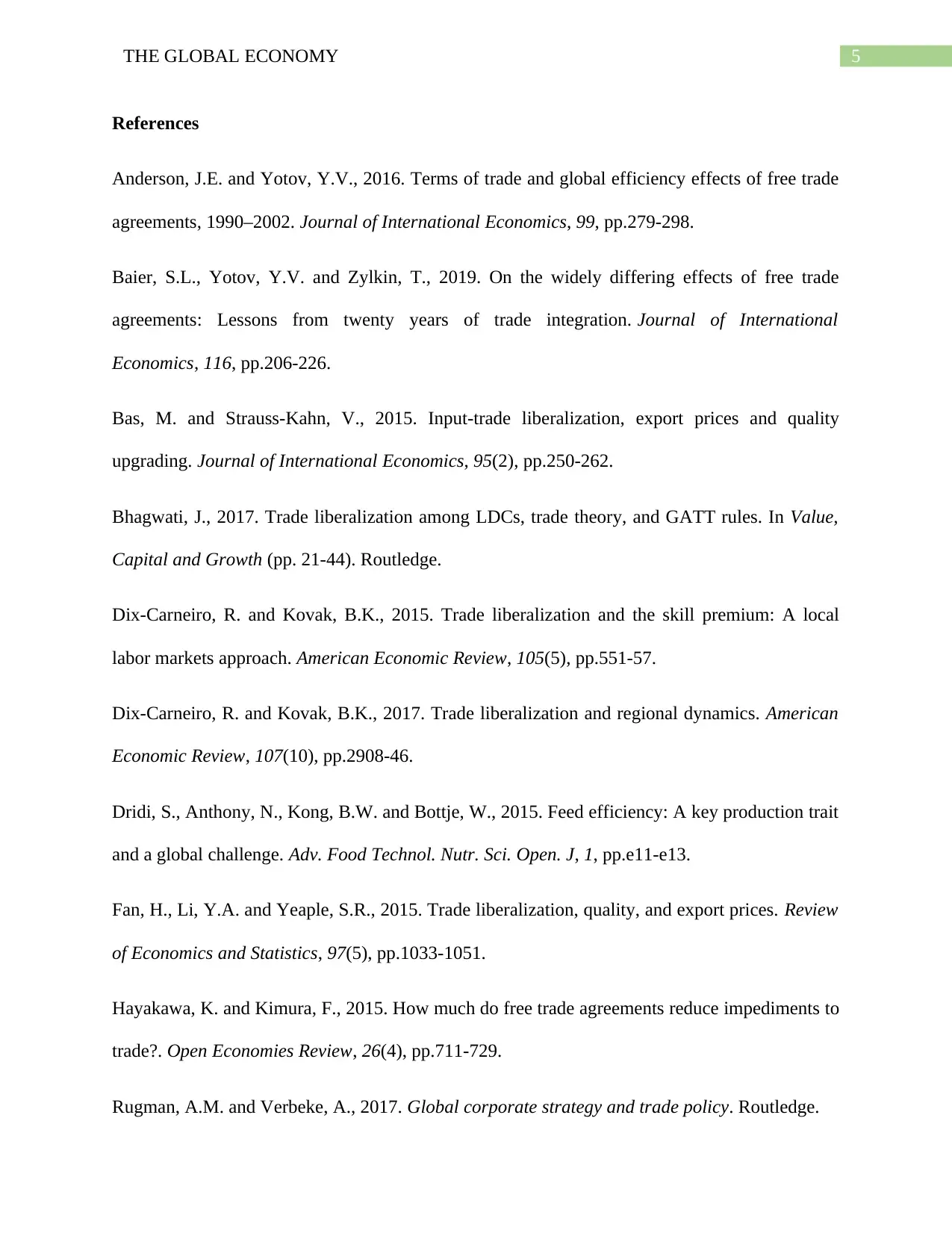
5THE GLOBAL ECONOMY
References
Anderson, J.E. and Yotov, Y.V., 2016. Terms of trade and global efficiency effects of free trade
agreements, 1990–2002. Journal of International Economics, 99, pp.279-298.
Baier, S.L., Yotov, Y.V. and Zylkin, T., 2019. On the widely differing effects of free trade
agreements: Lessons from twenty years of trade integration. Journal of International
Economics, 116, pp.206-226.
Bas, M. and Strauss-Kahn, V., 2015. Input-trade liberalization, export prices and quality
upgrading. Journal of International Economics, 95(2), pp.250-262.
Bhagwati, J., 2017. Trade liberalization among LDCs, trade theory, and GATT rules. In Value,
Capital and Growth (pp. 21-44). Routledge.
Dix-Carneiro, R. and Kovak, B.K., 2015. Trade liberalization and the skill premium: A local
labor markets approach. American Economic Review, 105(5), pp.551-57.
Dix-Carneiro, R. and Kovak, B.K., 2017. Trade liberalization and regional dynamics. American
Economic Review, 107(10), pp.2908-46.
Dridi, S., Anthony, N., Kong, B.W. and Bottje, W., 2015. Feed efficiency: A key production trait
and a global challenge. Adv. Food Technol. Nutr. Sci. Open. J, 1, pp.e11-e13.
Fan, H., Li, Y.A. and Yeaple, S.R., 2015. Trade liberalization, quality, and export prices. Review
of Economics and Statistics, 97(5), pp.1033-1051.
Hayakawa, K. and Kimura, F., 2015. How much do free trade agreements reduce impediments to
trade?. Open Economies Review, 26(4), pp.711-729.
Rugman, A.M. and Verbeke, A., 2017. Global corporate strategy and trade policy. Routledge.
References
Anderson, J.E. and Yotov, Y.V., 2016. Terms of trade and global efficiency effects of free trade
agreements, 1990–2002. Journal of International Economics, 99, pp.279-298.
Baier, S.L., Yotov, Y.V. and Zylkin, T., 2019. On the widely differing effects of free trade
agreements: Lessons from twenty years of trade integration. Journal of International
Economics, 116, pp.206-226.
Bas, M. and Strauss-Kahn, V., 2015. Input-trade liberalization, export prices and quality
upgrading. Journal of International Economics, 95(2), pp.250-262.
Bhagwati, J., 2017. Trade liberalization among LDCs, trade theory, and GATT rules. In Value,
Capital and Growth (pp. 21-44). Routledge.
Dix-Carneiro, R. and Kovak, B.K., 2015. Trade liberalization and the skill premium: A local
labor markets approach. American Economic Review, 105(5), pp.551-57.
Dix-Carneiro, R. and Kovak, B.K., 2017. Trade liberalization and regional dynamics. American
Economic Review, 107(10), pp.2908-46.
Dridi, S., Anthony, N., Kong, B.W. and Bottje, W., 2015. Feed efficiency: A key production trait
and a global challenge. Adv. Food Technol. Nutr. Sci. Open. J, 1, pp.e11-e13.
Fan, H., Li, Y.A. and Yeaple, S.R., 2015. Trade liberalization, quality, and export prices. Review
of Economics and Statistics, 97(5), pp.1033-1051.
Hayakawa, K. and Kimura, F., 2015. How much do free trade agreements reduce impediments to
trade?. Open Economies Review, 26(4), pp.711-729.
Rugman, A.M. and Verbeke, A., 2017. Global corporate strategy and trade policy. Routledge.
⊘ This is a preview!⊘
Do you want full access?
Subscribe today to unlock all pages.

Trusted by 1+ million students worldwide
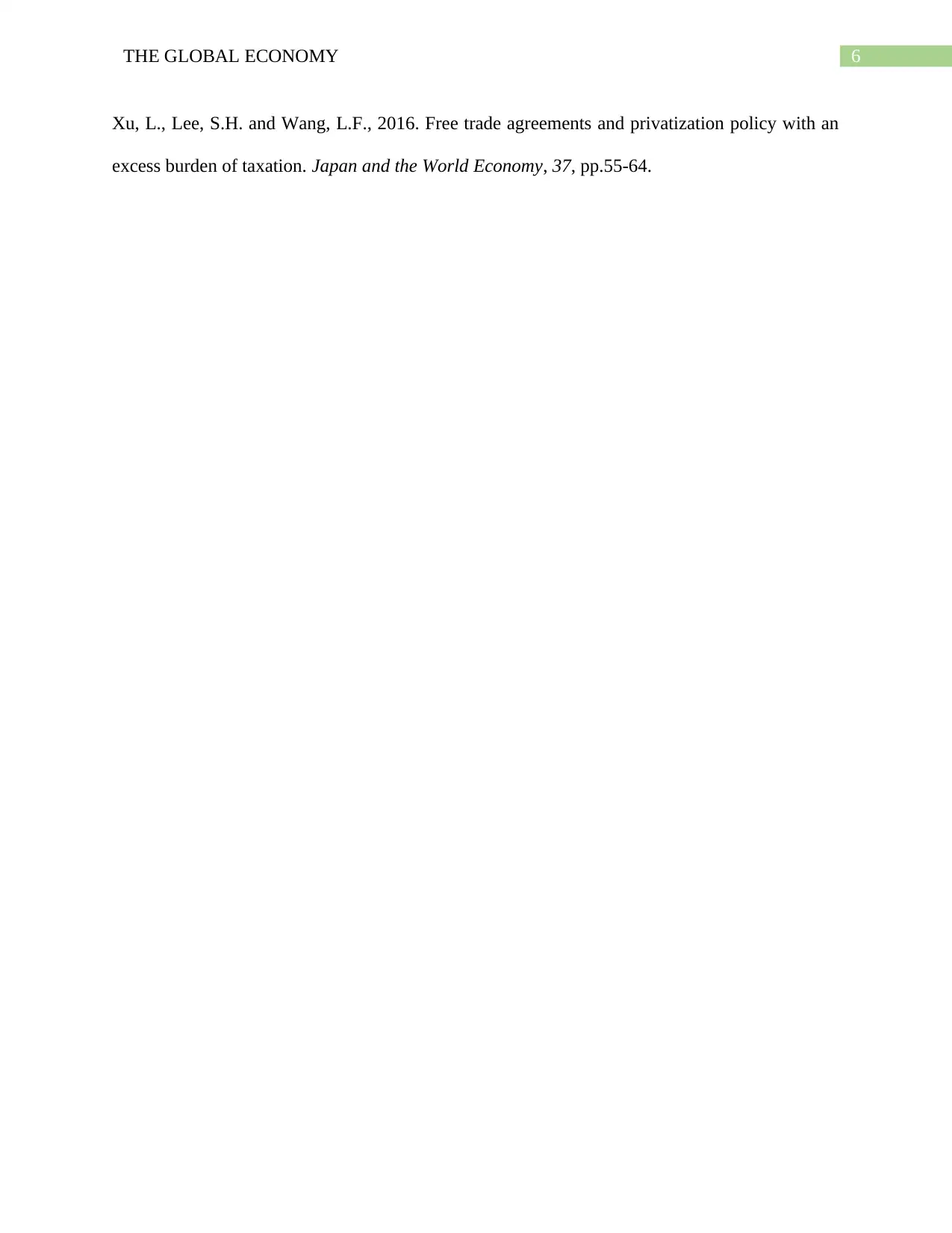
6THE GLOBAL ECONOMY
Xu, L., Lee, S.H. and Wang, L.F., 2016. Free trade agreements and privatization policy with an
excess burden of taxation. Japan and the World Economy, 37, pp.55-64.
Xu, L., Lee, S.H. and Wang, L.F., 2016. Free trade agreements and privatization policy with an
excess burden of taxation. Japan and the World Economy, 37, pp.55-64.
Paraphrase This Document
Need a fresh take? Get an instant paraphrase of this document with our AI Paraphraser
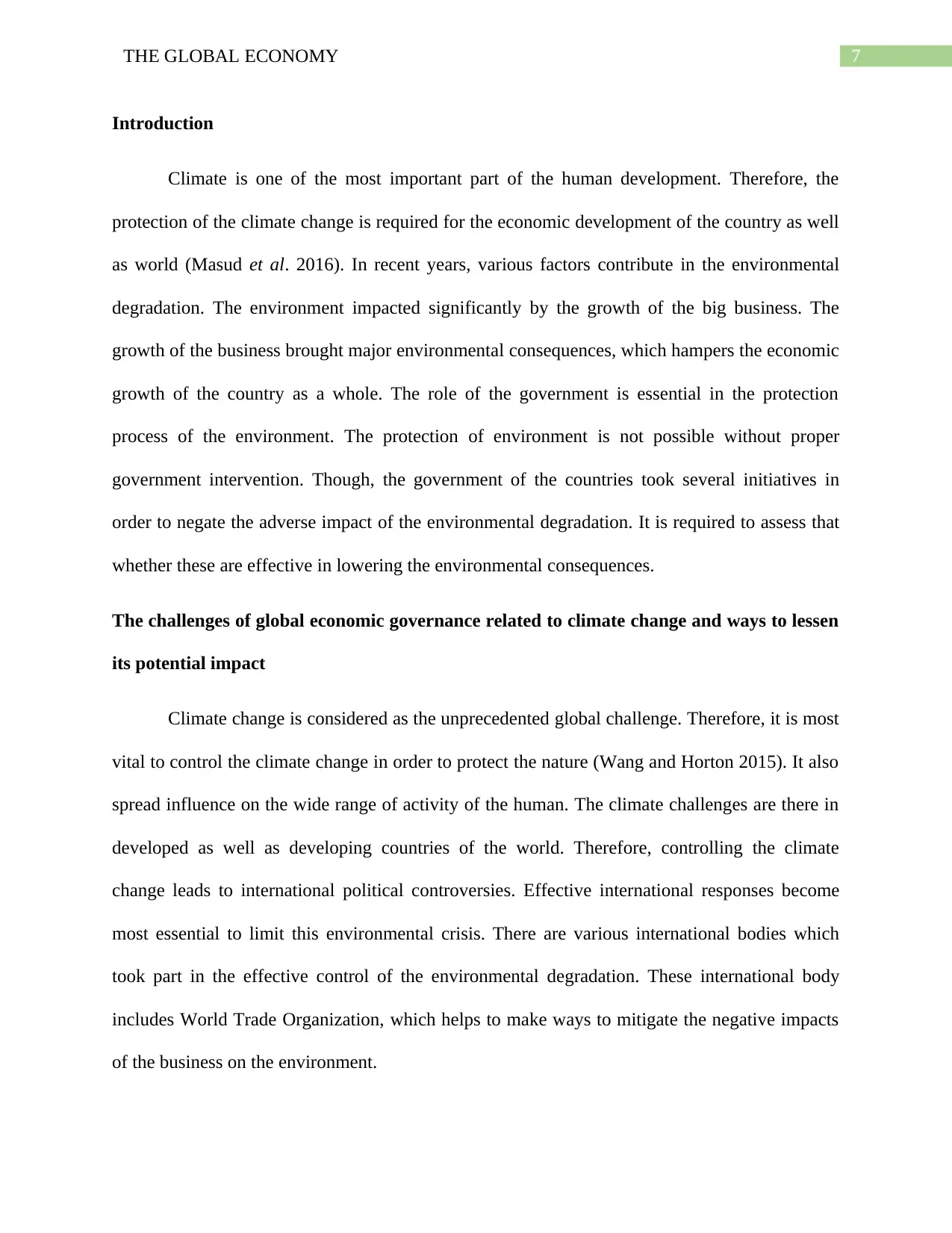
7THE GLOBAL ECONOMY
Introduction
Climate is one of the most important part of the human development. Therefore, the
protection of the climate change is required for the economic development of the country as well
as world (Masud et al. 2016). In recent years, various factors contribute in the environmental
degradation. The environment impacted significantly by the growth of the big business. The
growth of the business brought major environmental consequences, which hampers the economic
growth of the country as a whole. The role of the government is essential in the protection
process of the environment. The protection of environment is not possible without proper
government intervention. Though, the government of the countries took several initiatives in
order to negate the adverse impact of the environmental degradation. It is required to assess that
whether these are effective in lowering the environmental consequences.
The challenges of global economic governance related to climate change and ways to lessen
its potential impact
Climate change is considered as the unprecedented global challenge. Therefore, it is most
vital to control the climate change in order to protect the nature (Wang and Horton 2015). It also
spread influence on the wide range of activity of the human. The climate challenges are there in
developed as well as developing countries of the world. Therefore, controlling the climate
change leads to international political controversies. Effective international responses become
most essential to limit this environmental crisis. There are various international bodies which
took part in the effective control of the environmental degradation. These international body
includes World Trade Organization, which helps to make ways to mitigate the negative impacts
of the business on the environment.
Introduction
Climate is one of the most important part of the human development. Therefore, the
protection of the climate change is required for the economic development of the country as well
as world (Masud et al. 2016). In recent years, various factors contribute in the environmental
degradation. The environment impacted significantly by the growth of the big business. The
growth of the business brought major environmental consequences, which hampers the economic
growth of the country as a whole. The role of the government is essential in the protection
process of the environment. The protection of environment is not possible without proper
government intervention. Though, the government of the countries took several initiatives in
order to negate the adverse impact of the environmental degradation. It is required to assess that
whether these are effective in lowering the environmental consequences.
The challenges of global economic governance related to climate change and ways to lessen
its potential impact
Climate change is considered as the unprecedented global challenge. Therefore, it is most
vital to control the climate change in order to protect the nature (Wang and Horton 2015). It also
spread influence on the wide range of activity of the human. The climate challenges are there in
developed as well as developing countries of the world. Therefore, controlling the climate
change leads to international political controversies. Effective international responses become
most essential to limit this environmental crisis. There are various international bodies which
took part in the effective control of the environmental degradation. These international body
includes World Trade Organization, which helps to make ways to mitigate the negative impacts
of the business on the environment.
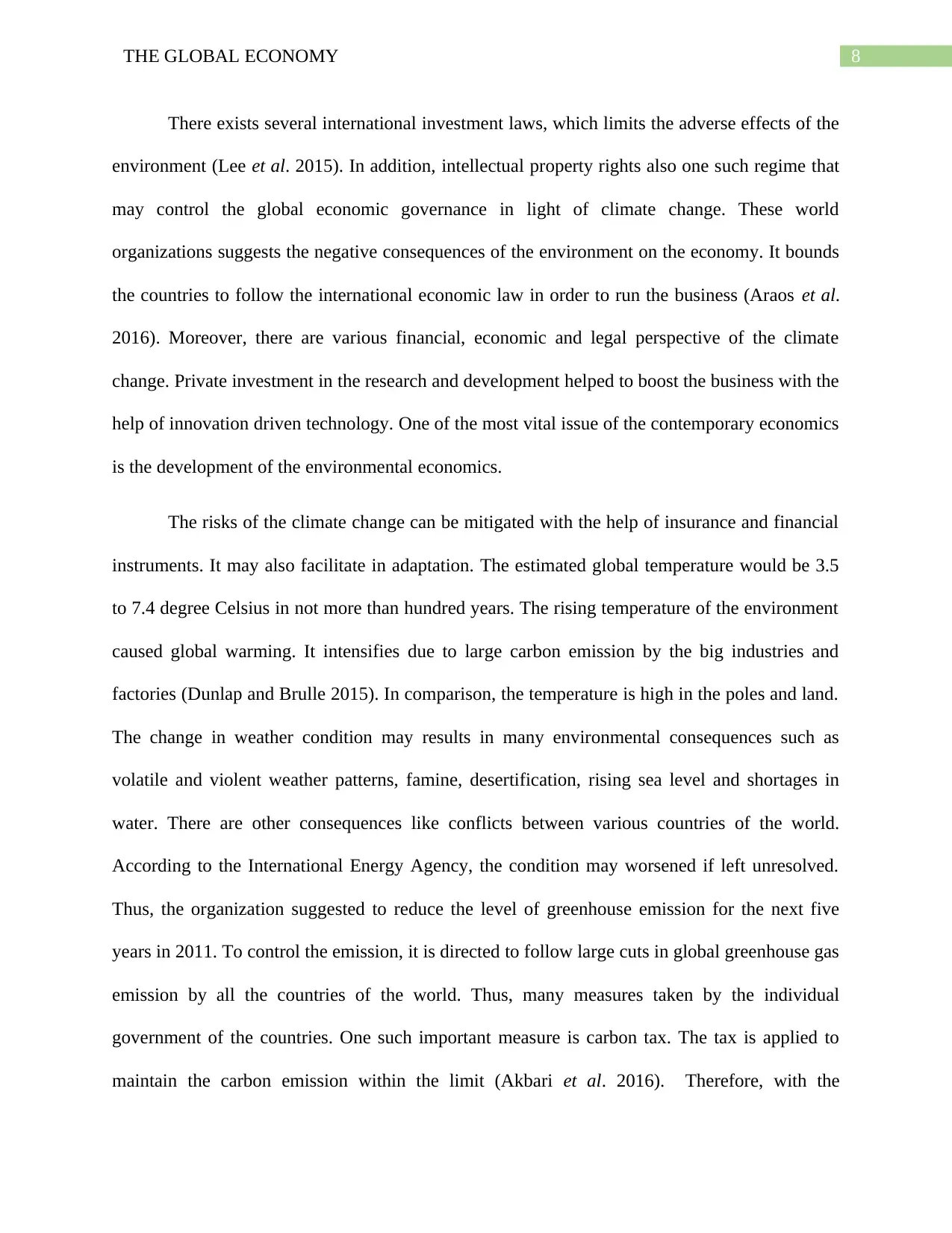
8THE GLOBAL ECONOMY
There exists several international investment laws, which limits the adverse effects of the
environment (Lee et al. 2015). In addition, intellectual property rights also one such regime that
may control the global economic governance in light of climate change. These world
organizations suggests the negative consequences of the environment on the economy. It bounds
the countries to follow the international economic law in order to run the business (Araos et al.
2016). Moreover, there are various financial, economic and legal perspective of the climate
change. Private investment in the research and development helped to boost the business with the
help of innovation driven technology. One of the most vital issue of the contemporary economics
is the development of the environmental economics.
The risks of the climate change can be mitigated with the help of insurance and financial
instruments. It may also facilitate in adaptation. The estimated global temperature would be 3.5
to 7.4 degree Celsius in not more than hundred years. The rising temperature of the environment
caused global warming. It intensifies due to large carbon emission by the big industries and
factories (Dunlap and Brulle 2015). In comparison, the temperature is high in the poles and land.
The change in weather condition may results in many environmental consequences such as
volatile and violent weather patterns, famine, desertification, rising sea level and shortages in
water. There are other consequences like conflicts between various countries of the world.
According to the International Energy Agency, the condition may worsened if left unresolved.
Thus, the organization suggested to reduce the level of greenhouse emission for the next five
years in 2011. To control the emission, it is directed to follow large cuts in global greenhouse gas
emission by all the countries of the world. Thus, many measures taken by the individual
government of the countries. One such important measure is carbon tax. The tax is applied to
maintain the carbon emission within the limit (Akbari et al. 2016). Therefore, with the
There exists several international investment laws, which limits the adverse effects of the
environment (Lee et al. 2015). In addition, intellectual property rights also one such regime that
may control the global economic governance in light of climate change. These world
organizations suggests the negative consequences of the environment on the economy. It bounds
the countries to follow the international economic law in order to run the business (Araos et al.
2016). Moreover, there are various financial, economic and legal perspective of the climate
change. Private investment in the research and development helped to boost the business with the
help of innovation driven technology. One of the most vital issue of the contemporary economics
is the development of the environmental economics.
The risks of the climate change can be mitigated with the help of insurance and financial
instruments. It may also facilitate in adaptation. The estimated global temperature would be 3.5
to 7.4 degree Celsius in not more than hundred years. The rising temperature of the environment
caused global warming. It intensifies due to large carbon emission by the big industries and
factories (Dunlap and Brulle 2015). In comparison, the temperature is high in the poles and land.
The change in weather condition may results in many environmental consequences such as
volatile and violent weather patterns, famine, desertification, rising sea level and shortages in
water. There are other consequences like conflicts between various countries of the world.
According to the International Energy Agency, the condition may worsened if left unresolved.
Thus, the organization suggested to reduce the level of greenhouse emission for the next five
years in 2011. To control the emission, it is directed to follow large cuts in global greenhouse gas
emission by all the countries of the world. Thus, many measures taken by the individual
government of the countries. One such important measure is carbon tax. The tax is applied to
maintain the carbon emission within the limit (Akbari et al. 2016). Therefore, with the
⊘ This is a preview!⊘
Do you want full access?
Subscribe today to unlock all pages.

Trusted by 1+ million students worldwide
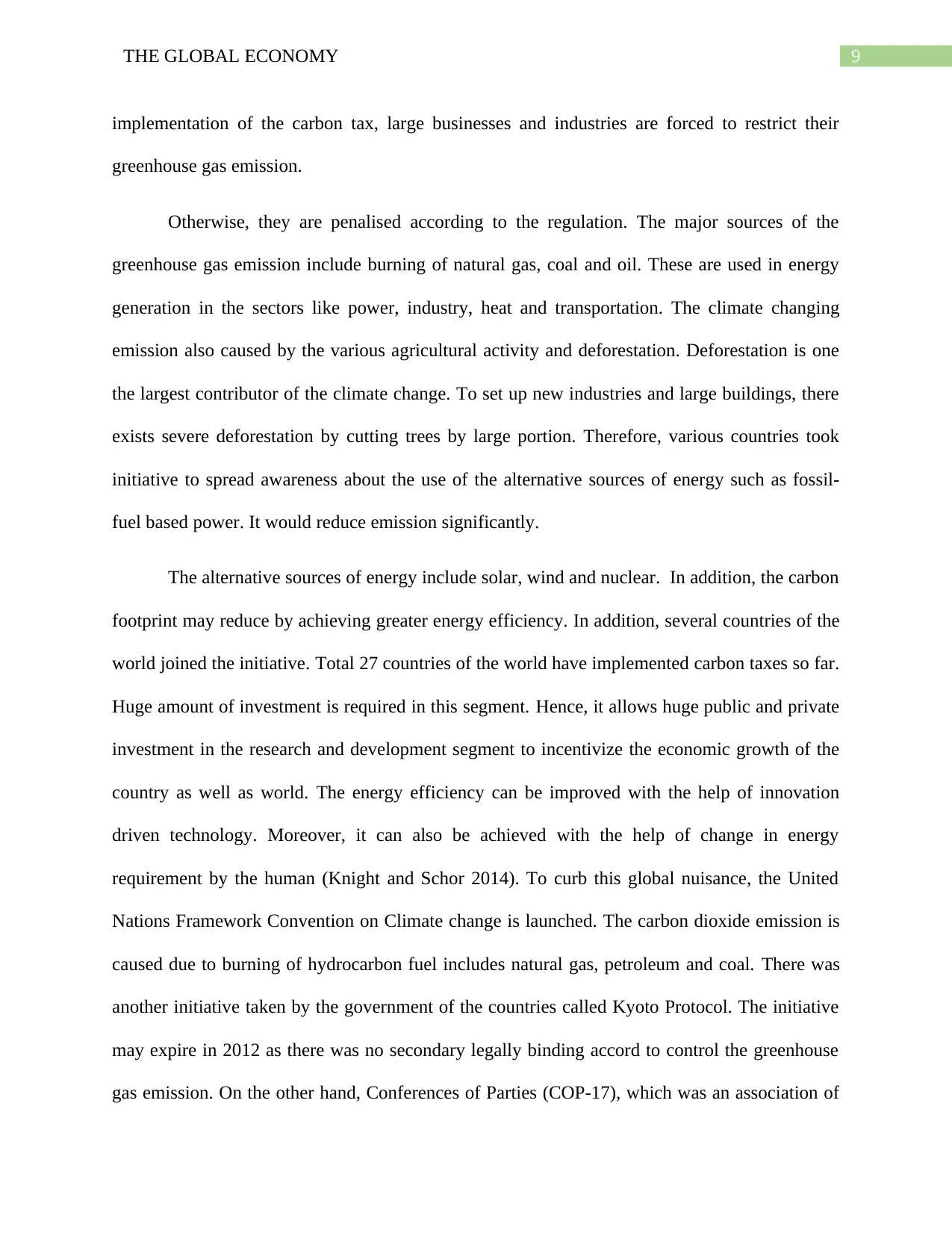
9THE GLOBAL ECONOMY
implementation of the carbon tax, large businesses and industries are forced to restrict their
greenhouse gas emission.
Otherwise, they are penalised according to the regulation. The major sources of the
greenhouse gas emission include burning of natural gas, coal and oil. These are used in energy
generation in the sectors like power, industry, heat and transportation. The climate changing
emission also caused by the various agricultural activity and deforestation. Deforestation is one
the largest contributor of the climate change. To set up new industries and large buildings, there
exists severe deforestation by cutting trees by large portion. Therefore, various countries took
initiative to spread awareness about the use of the alternative sources of energy such as fossil-
fuel based power. It would reduce emission significantly.
The alternative sources of energy include solar, wind and nuclear. In addition, the carbon
footprint may reduce by achieving greater energy efficiency. In addition, several countries of the
world joined the initiative. Total 27 countries of the world have implemented carbon taxes so far.
Huge amount of investment is required in this segment. Hence, it allows huge public and private
investment in the research and development segment to incentivize the economic growth of the
country as well as world. The energy efficiency can be improved with the help of innovation
driven technology. Moreover, it can also be achieved with the help of change in energy
requirement by the human (Knight and Schor 2014). To curb this global nuisance, the United
Nations Framework Convention on Climate change is launched. The carbon dioxide emission is
caused due to burning of hydrocarbon fuel includes natural gas, petroleum and coal. There was
another initiative taken by the government of the countries called Kyoto Protocol. The initiative
may expire in 2012 as there was no secondary legally binding accord to control the greenhouse
gas emission. On the other hand, Conferences of Parties (COP-17), which was an association of
implementation of the carbon tax, large businesses and industries are forced to restrict their
greenhouse gas emission.
Otherwise, they are penalised according to the regulation. The major sources of the
greenhouse gas emission include burning of natural gas, coal and oil. These are used in energy
generation in the sectors like power, industry, heat and transportation. The climate changing
emission also caused by the various agricultural activity and deforestation. Deforestation is one
the largest contributor of the climate change. To set up new industries and large buildings, there
exists severe deforestation by cutting trees by large portion. Therefore, various countries took
initiative to spread awareness about the use of the alternative sources of energy such as fossil-
fuel based power. It would reduce emission significantly.
The alternative sources of energy include solar, wind and nuclear. In addition, the carbon
footprint may reduce by achieving greater energy efficiency. In addition, several countries of the
world joined the initiative. Total 27 countries of the world have implemented carbon taxes so far.
Huge amount of investment is required in this segment. Hence, it allows huge public and private
investment in the research and development segment to incentivize the economic growth of the
country as well as world. The energy efficiency can be improved with the help of innovation
driven technology. Moreover, it can also be achieved with the help of change in energy
requirement by the human (Knight and Schor 2014). To curb this global nuisance, the United
Nations Framework Convention on Climate change is launched. The carbon dioxide emission is
caused due to burning of hydrocarbon fuel includes natural gas, petroleum and coal. There was
another initiative taken by the government of the countries called Kyoto Protocol. The initiative
may expire in 2012 as there was no secondary legally binding accord to control the greenhouse
gas emission. On the other hand, Conferences of Parties (COP-17), which was an association of
Paraphrase This Document
Need a fresh take? Get an instant paraphrase of this document with our AI Paraphraser
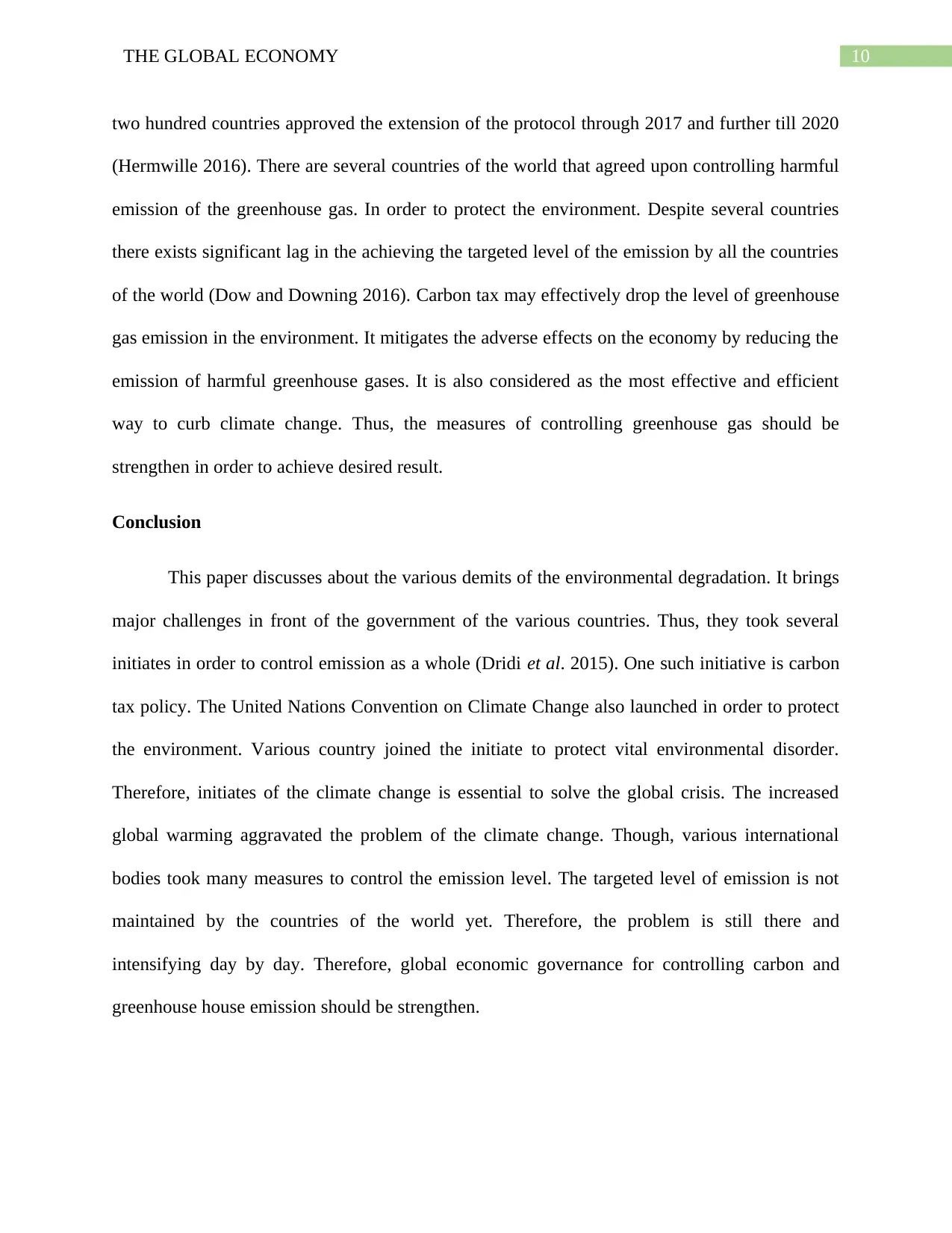
10THE GLOBAL ECONOMY
two hundred countries approved the extension of the protocol through 2017 and further till 2020
(Hermwille 2016). There are several countries of the world that agreed upon controlling harmful
emission of the greenhouse gas. In order to protect the environment. Despite several countries
there exists significant lag in the achieving the targeted level of the emission by all the countries
of the world (Dow and Downing 2016). Carbon tax may effectively drop the level of greenhouse
gas emission in the environment. It mitigates the adverse effects on the economy by reducing the
emission of harmful greenhouse gases. It is also considered as the most effective and efficient
way to curb climate change. Thus, the measures of controlling greenhouse gas should be
strengthen in order to achieve desired result.
Conclusion
This paper discusses about the various demits of the environmental degradation. It brings
major challenges in front of the government of the various countries. Thus, they took several
initiates in order to control emission as a whole (Dridi et al. 2015). One such initiative is carbon
tax policy. The United Nations Convention on Climate Change also launched in order to protect
the environment. Various country joined the initiate to protect vital environmental disorder.
Therefore, initiates of the climate change is essential to solve the global crisis. The increased
global warming aggravated the problem of the climate change. Though, various international
bodies took many measures to control the emission level. The targeted level of emission is not
maintained by the countries of the world yet. Therefore, the problem is still there and
intensifying day by day. Therefore, global economic governance for controlling carbon and
greenhouse house emission should be strengthen.
two hundred countries approved the extension of the protocol through 2017 and further till 2020
(Hermwille 2016). There are several countries of the world that agreed upon controlling harmful
emission of the greenhouse gas. In order to protect the environment. Despite several countries
there exists significant lag in the achieving the targeted level of the emission by all the countries
of the world (Dow and Downing 2016). Carbon tax may effectively drop the level of greenhouse
gas emission in the environment. It mitigates the adverse effects on the economy by reducing the
emission of harmful greenhouse gases. It is also considered as the most effective and efficient
way to curb climate change. Thus, the measures of controlling greenhouse gas should be
strengthen in order to achieve desired result.
Conclusion
This paper discusses about the various demits of the environmental degradation. It brings
major challenges in front of the government of the various countries. Thus, they took several
initiates in order to control emission as a whole (Dridi et al. 2015). One such initiative is carbon
tax policy. The United Nations Convention on Climate Change also launched in order to protect
the environment. Various country joined the initiate to protect vital environmental disorder.
Therefore, initiates of the climate change is essential to solve the global crisis. The increased
global warming aggravated the problem of the climate change. Though, various international
bodies took many measures to control the emission level. The targeted level of emission is not
maintained by the countries of the world yet. Therefore, the problem is still there and
intensifying day by day. Therefore, global economic governance for controlling carbon and
greenhouse house emission should be strengthen.
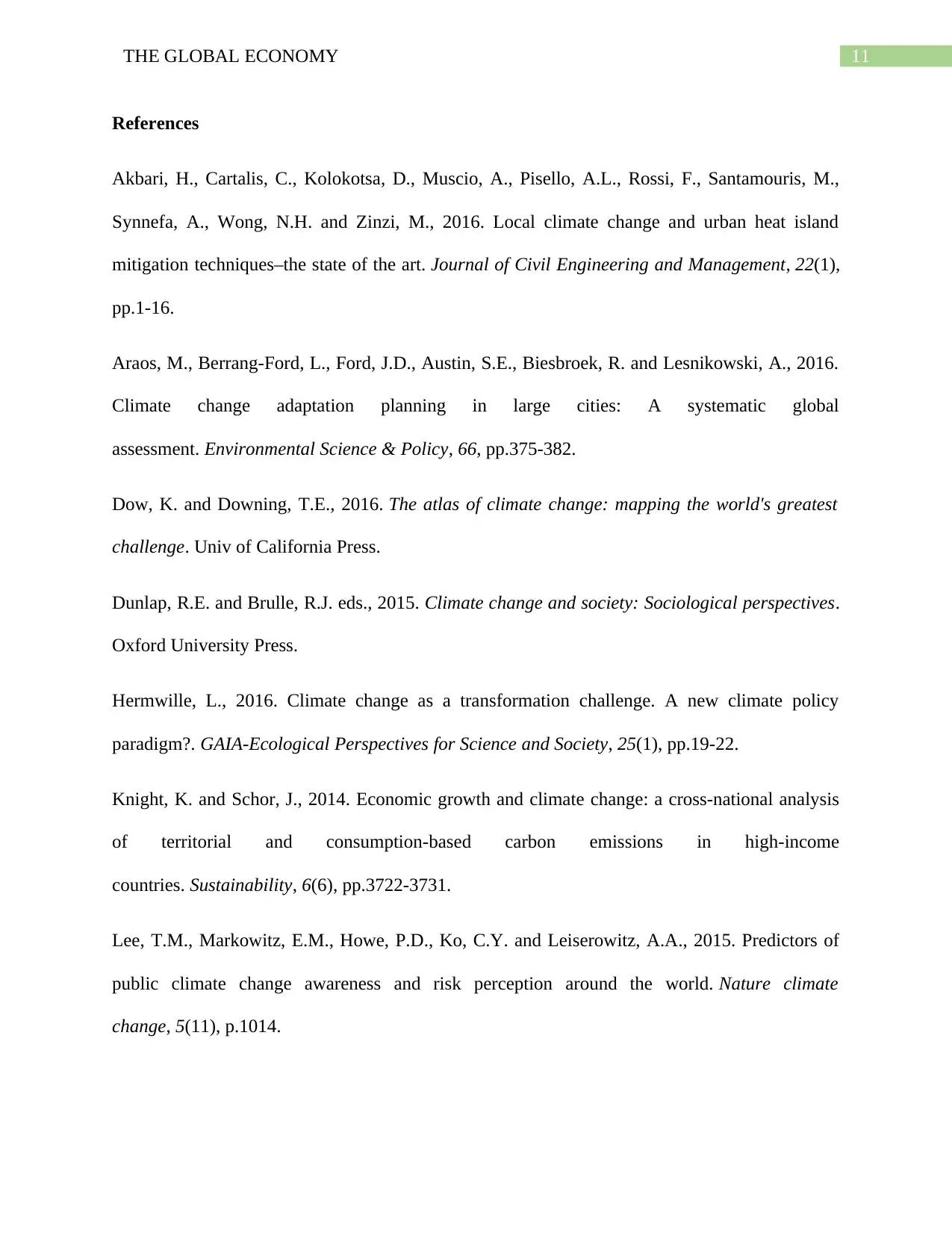
11THE GLOBAL ECONOMY
References
Akbari, H., Cartalis, C., Kolokotsa, D., Muscio, A., Pisello, A.L., Rossi, F., Santamouris, M.,
Synnefa, A., Wong, N.H. and Zinzi, M., 2016. Local climate change and urban heat island
mitigation techniques–the state of the art. Journal of Civil Engineering and Management, 22(1),
pp.1-16.
Araos, M., Berrang-Ford, L., Ford, J.D., Austin, S.E., Biesbroek, R. and Lesnikowski, A., 2016.
Climate change adaptation planning in large cities: A systematic global
assessment. Environmental Science & Policy, 66, pp.375-382.
Dow, K. and Downing, T.E., 2016. The atlas of climate change: mapping the world's greatest
challenge. Univ of California Press.
Dunlap, R.E. and Brulle, R.J. eds., 2015. Climate change and society: Sociological perspectives.
Oxford University Press.
Hermwille, L., 2016. Climate change as a transformation challenge. A new climate policy
paradigm?. GAIA-Ecological Perspectives for Science and Society, 25(1), pp.19-22.
Knight, K. and Schor, J., 2014. Economic growth and climate change: a cross-national analysis
of territorial and consumption-based carbon emissions in high-income
countries. Sustainability, 6(6), pp.3722-3731.
Lee, T.M., Markowitz, E.M., Howe, P.D., Ko, C.Y. and Leiserowitz, A.A., 2015. Predictors of
public climate change awareness and risk perception around the world. Nature climate
change, 5(11), p.1014.
References
Akbari, H., Cartalis, C., Kolokotsa, D., Muscio, A., Pisello, A.L., Rossi, F., Santamouris, M.,
Synnefa, A., Wong, N.H. and Zinzi, M., 2016. Local climate change and urban heat island
mitigation techniques–the state of the art. Journal of Civil Engineering and Management, 22(1),
pp.1-16.
Araos, M., Berrang-Ford, L., Ford, J.D., Austin, S.E., Biesbroek, R. and Lesnikowski, A., 2016.
Climate change adaptation planning in large cities: A systematic global
assessment. Environmental Science & Policy, 66, pp.375-382.
Dow, K. and Downing, T.E., 2016. The atlas of climate change: mapping the world's greatest
challenge. Univ of California Press.
Dunlap, R.E. and Brulle, R.J. eds., 2015. Climate change and society: Sociological perspectives.
Oxford University Press.
Hermwille, L., 2016. Climate change as a transformation challenge. A new climate policy
paradigm?. GAIA-Ecological Perspectives for Science and Society, 25(1), pp.19-22.
Knight, K. and Schor, J., 2014. Economic growth and climate change: a cross-national analysis
of territorial and consumption-based carbon emissions in high-income
countries. Sustainability, 6(6), pp.3722-3731.
Lee, T.M., Markowitz, E.M., Howe, P.D., Ko, C.Y. and Leiserowitz, A.A., 2015. Predictors of
public climate change awareness and risk perception around the world. Nature climate
change, 5(11), p.1014.
⊘ This is a preview!⊘
Do you want full access?
Subscribe today to unlock all pages.

Trusted by 1+ million students worldwide
1 out of 13
Related Documents
Your All-in-One AI-Powered Toolkit for Academic Success.
+13062052269
info@desklib.com
Available 24*7 on WhatsApp / Email
![[object Object]](/_next/static/media/star-bottom.7253800d.svg)
Unlock your academic potential
Copyright © 2020–2025 A2Z Services. All Rights Reserved. Developed and managed by ZUCOL.





